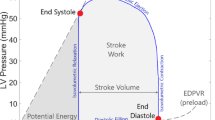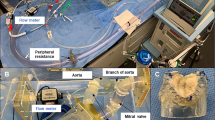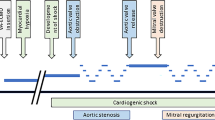Abstract
Cardiac pressure-volume relations enable quantification of intrinsic ventricular diastolic and systolic properties independent of loading conditions. The use of pressure-volume loop analysis in early stages of development could contribute to a better understanding of the relationship between hemodynamics and cardiac morphogenesis. The venous clip model is an intervention model for the chick embryo in which permanent obstruction of the right lateral vitelline vein temporarily reduces the mechanical load on the embryonic myocardium and induces a spectrum of outflow tract anomalies. We used pressure-volume loop analysis of the embryonic chick heart at stage 21 (3.5 d of incubation) to investigate whether the development of ventricular function is affected by venous clipping at stage 17, compared with normal control embryos. Steady state hemodynamic parameters demonstrated no significant differences between the venous clipped and control embryos. However, analysis of pressure-volume relations showed a significantly lower end-systolic elastance in the clipped embryos (slope of the end-systolic pressure-volume relation: 5.68 ± 0.85 versus 11.76 ± 2.70 mm Hg/μL, p < 0.05), indicating reduced contractility. Diastolic stiffness tended to be increased in the clipped embryos (slope of end-diastolic pressure-volume relation: 2.74 ± 0.56 versus 1.67 ± 0.21, p = 0.103), but the difference did not reach statistical significance. The results of the pressure-volume loop analysis show that 1 d after venous obstruction, development of ventricular function is affected, with reduced contractility. Pressure-volume analysis may be applied in the chick embryo and is a sensitive technique to detect subtle alterations in ventricular function.
Similar content being viewed by others
Log in or create a free account to read this content
Gain free access to this article, as well as selected content from this journal and more on nature.com
or
Abbreviations
- CO:
-
cardiac output
- EDP:
-
end-diastolic pressure
- EDPVR:
-
end-diastolic pressure-volume relation
- EDV:
-
end-diastolic volume
- EED:
-
end-diastolic stiffness
- EES:
-
end-systolic elastance
- EF:
-
ejection fraction
- ESP:
-
end-systolic pressure
- ESPVR:
-
end-systolic pressure-volume relation
- ESV:
-
end-systolic volume
- ESV2:
-
end-systolic volume at 2 mm Hg
- HH:
-
Hamburger and Hamilton
- HR:
-
heart rate
- PER:
-
peak ejection rate
- PFR:
-
peak filling rate
- PHT:
-
pressure half time
- SV:
-
stroke volume
- SW:
-
stroke work
References
Clark EB, Hu N 1982 Developmental hemodynamic changes in the chick embryo from stage 18 to 27. Circ Res 51: 810–815
Nakazawa M, Miyagawa S, Ohno T, Miura S, Takao A 1988 Developmental hemodynamic changes in rat embryos at 11 to 15 days of gestation: normal data of blood pressure and the effect of caffeine compared to data from chick embryo. Pediatr Res 23: 200–205
Stekelenburg De Vos S, Ursem NT, Hop WC, Wladimiroff JW, Gittenberger-de Groot AC, Poelmann RE 2003 Acutely altered hemodynamics following venous obstruction in the early chick embryo. J Exp Biol 206: 1051–1057
Hogers B, DeRuiter MC, Gittenberger-de Groot AC, Poelmann RE 1997 Unilateral vitelline vein ligation alters intracardiac blood flow patterns and morphogenesis in the chick embryo. Circ Res 80: 473–481
Clark EB, Hu N, Dummett JL, Vandekieft GK, Olson C, Tomanek R 1986 Ventricular function and morphology in chick embryo from stages 18 to 29. Am J Physiol 250: H407–H413
Hu N, Clark EB 1989 Hemodynamics of the stage 12 to stage 29 chick embryo. Circ Res 65: 1665–1670
Broekhuizen ML, Mast F, Struijk PC, van der Bie W, Mulder PG, Gittenberger-de Groot AC, Wladimiroff JW 1993 Hemodynamic parameters of stage 20 to stage 35 chick embryo. Pediatr Res 34: 44–46
Hamburger V, Hamilton HL 1951 A series of normal stages in the development of the chick embryo. J Morphol 88: 49–92
Keller BB, Tinney JP, Hu N 1994 Embryonic ventricular diastolic and systolic pressure-volume relations. Cardiol Young 4: 19–27
Kass DA, Yamazaki T, Burkhoff D, Maughan WL, Sagawa K 1986 Determination of left ventricular end-systolic pressure-volume relationships by the conductance (volume) catheter technique. Circulation 73: 586–595
Teitel DF, Klautz R, Steendijk P, van der Velde ET, van Bel F, Baan J 1991 The end-systolic pressure-volume relationship in the newborn lamb: effects of loading and inotropic interventions. Pediatr Res 29: 473–482
Georgakopoulos D, Mitzner WA, Chen CH, Byrne BJ, Millar HD, Hare JM, Kass DA 1998 In vivo murine left ventricular pressure-volume relations by miniaturized conductance micromanometry. Am J Physiol 274: H1416–H1422
Lewinsky RM, Szwarc RS, Benson LN, Ritchie JW 1993 The effects of hypoxic acidemia on left ventricular end-systolic elastance in fetal sheep. Pediatr Res 34: 38–43
Weil SR, Russo PA, Heckman JL, Balsara RK, Pasiecki V, Dunn JM 1993 Pressure-volume relationship of the fetal lamb heart. Ann Thorac Surg 55: 470–475
Keller BB, Yoshigi M, Tinney JP 1997 Ventricular-vascular uncoupling by acute conotruncal occlusion in the stage 21 chick embryo. Am J Physiol 273: H2861–H2866
Hove JR, Koster RW, Forouhar AS, Acevedo-Bolton G, Fraser SE, Gharib M 2003 Intracardiac fluid forces are an essential epigenetic factor for embryonic cardiogenesis. Nature 421: 172–177
Heineman FW, Grayson J 1985 Transmural distribution of intramyocardial pressure measured by micropipette technique. Am J Physiol 249: H1216–H1223
Gundersen HJ, Jensen EB 1987 The efficiency of systematic sampling in stereology and its prediction. J Microsc 147: 229–263
Sagawa K, Maughan L, Suga H, Sunagawa K 1988 Cardiac contraction and the pressure-volume relationship. Oxford University Press, New York pp 36–39
Kono A, Maughan WL, Sunagawa K, Hamilton K, Sagawa K, Weisfeldt ML 1984 The use of left ventricular end-ejection pressure and peak pressure in the estimation of the end-systolic pressure-volume relationship. Circulation 70: 1057–1065
Leeuwenburgh BP, Steendijk P, Helbing WA, Baan J 2002 Indexes of diastolic RV function: load dependence and changes after chronic RV pressure overload in lambs. Am J Physiol Heart Circ Physiol 282: H1350–H1358
Steendijk P, Baan J Jr Van der Velde ET, Baan J 1998 Effects of critical coronary stenosis on global systolic left ventricular function quantified by pressure-volume relations during dobutamine stress in the canine heart. J Am Coll Cardiol 32: 816–826
Pak PH, Maughan L, Baughman KL, Kass DA 1996 Marked discordance between dynamic and passive diastolic pressure-volume relations in idiopathic hypertrophic cardiomyopathy. Circulation 94: 52–60
Bland JM, Altman DG 1996 Transforming data. BMJ 312: 770
Hogers B, Gittenberger-de Groot AC, DeRuiter MC, Mentink MM, Poelmann RE 1998 Cardiac inflow malformations are more lethal and precede cardiac outflow malformations. Chick embryonic venous clip model. In: Hogers B (ed) The Role of Blood Flow in Normal and Abnormal Heart Development. Ponsen & Looijen BV, Wageningen, The Netherlands pp 79–100
Nakanishi T, Seguchi M, Takao A 1988 Development of the myocardial contractile system. Experientia 44: 936–944
Godt RE, Fogaca RT, Nosek TM 1991 Changes in force and calcium sensitivity in the developing avian heart. Can J Physiol Pharmacol 69: 1692–1697
Anderson PA 1996 The heart and development. Semin Perinatol 20: 482–509
Tobita K, Keller BB 2000 Maturation of end-systolic stress-strain relations in chick embryonic myocardium. Am J Physiol Heart Circ Physiol 279: H216–H224
Clark EB, Hu N, Frommelt P, Vandekieft GK, Dummett JL, Tomanek RJ 1989 Effect of increased pressure on ventricular growth in stage 21 chick embryos. Am J Physiol 257: H55–H61
Schroder EA, Tobita K, Tinney JP, Foldes JK, Keller BB 2002 Microtubule involvement in the adaptation to altered mechanical load in developing chick myocardium. Circ Res 91: 353–359
Gilbert JC, Glantz SA 1989 Determinants of left ventricular filling and of the diastolic pressure-volume relation. Circ Res 64: 827–852
Friedman WF 1972 The intrinsic physiologic properties of the developing heart. Prog Cardiovasc Dis 15: 87–111
Hu N, Connuck DM, Keller BB, Clark EB 1991 Diastolic filling characteristics in the stage 12 to 27 chick embryo ventricle. Pediatr Res 29: 334–337
Granzier H, Labeit S 2002 Cardiac titin: an adjustable multi-functional spring. J Physiol 541: 335–342
Epstein ND, Davis JS 2003 Sensing stretch is fundamental. Cell 112: 147–150
Wu Y, Bell SP, Trombitas K, Witt CC, Labeit S, LeWinter MM, Granzier H 2002 Changes in titin isoform expression in pacing-induced cardiac failure give rise to increased passive muscle stiffness. Circulation 106: 1384–1389
Ursem NT, Stekelenburg-de Vos S, Wladimiroff JW, Poelmann RE, Gittenberger-de Groot AC, Hu N, Clark EB 2004 Ventricular diastolic characteristics in stage-24 chick embryos after extra-embryonic venous obstruction. J Exp Biol 207: 1487–1490
Tobita K, Keller BB 1999 End-systolic myocardial stiffness is a load-independent index of contractility in stage 24 chick embryonic heart. Am J Physiol 276: H2102–2108
Author information
Authors and Affiliations
Corresponding author
Additional information
Supported by Grant 2000.016 from the Netherlands Heart Foundation.
Rights and permissions
About this article
Cite this article
Stekelenburg-de Vos, S., Steendijk, P., Ursem, N. et al. Systolic and Diastolic Ventricular Function Assessed by Pressure-Volume Loops in the Stage 21 Venous Clipped Chick Embryo. Pediatr Res 57, 16–21 (2005). https://doi.org/10.1203/01.PDR.0000147734.53277.75
Received:
Accepted:
Issue date:
DOI: https://doi.org/10.1203/01.PDR.0000147734.53277.75
This article is cited by
-
Assessing Pressure–Volume Relationship in Developing Heart of Zebrafish In-Vivo
Annals of Biomedical Engineering (2021)
-
Organ Dynamics and Hemodynamic of the Whole HH25 Avian Embryonic Heart, Revealed by Ultrasound Biomicroscopy, Boundary Tracking, and Flow Simulations
Scientific Reports (2019)
-
Biomechanics of early cardiac development
Biomechanics and Modeling in Mechanobiology (2012)
-
The development of the heart and microcirculation: role of shear stress
Medical & Biological Engineering & Computing (2008)
-
Begin at the beginning: some reflections on future periconceptional and obstetric care and research in the Netherlands
European Clinics in Obstetrics and Gynaecology (2005)



